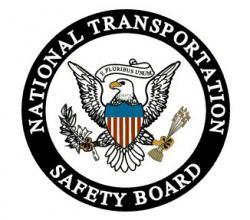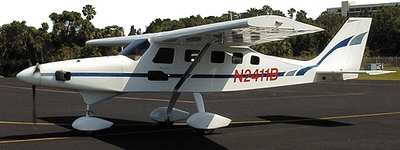High-Performance Experimental Turbine Goes Down After Balked
Landing
 No matter the sum of one's experience, there is no
substitute for having 'time in type.' In the case of a recent fatal
Comp Air 8 Turboprop taildragger accident, the ferry pilot had a
fair amount of PIC time overall, but a comparatively short amount
of time in type... and with a machine like the CA8, with a
significant power to weight ratio, knowing the bird is a big deal
when it comes to correcting a bad situation like a balked landing.
Had this pilot not passed up the chance for a little additional
training in type, this tragedy might have been avoided.
No matter the sum of one's experience, there is no
substitute for having 'time in type.' In the case of a recent fatal
Comp Air 8 Turboprop taildragger accident, the ferry pilot had a
fair amount of PIC time overall, but a comparatively short amount
of time in type... and with a machine like the CA8, with a
significant power to weight ratio, knowing the bird is a big deal
when it comes to correcting a bad situation like a balked landing.
Had this pilot not passed up the chance for a little additional
training in type, this tragedy might have been avoided.
NTSB Identification: ERA10LA365
14 CFR Part 91: General Aviation
Accident occurred Monday, July 19, 2010 in Mount Pleasant, SC
Aircraft: TEXAS AIR VENTURES INC COMP AIR 8, registration:
N882X
Injuries: 1 Fatal.
This is preliminary information, subject to change, and may
contain errors. Any errors in this report will be corrected when
the final report has been completed.
On July 19, 2010, about 1400 eastern daylight time, an
experimental, amateur-built Texas Air Ventures Comp Air 8, N882X,
was substantially damaged when it impacted the ground during an
aborted landing at Mt. Pleasant Regional Airport (LRO), Mount
Pleasant, South Carolina. The certificated commercial pilot was
killed. Visual meteorological conditions prevailed and an
instrument flight rules (IFR) flight plan had been filed for the
flight that departed Merritt Island Airport (COI), Merritt Island,
Florida, about 1200. The ferry flight was conducted under the
provisions of Title 14 Code of Federal Regulations Part 91.
According to witnesses, at the time of the accident, the pilot
was flying the first leg of a ferry flight with the intention of
delivering the airplane to its owner in Holland, who had purchased
the airplane about 3 months prior to the accident.
A witness, who worked for a fixed-base-operator at LRO, reported
that the airplane was scheduled to overnight at the airport. He
also witnessed the airplane on approach to runway 17, a
3,700-foot-long, 75-foot-wide, asphalt runway. The witness stated
that the airplane looked "a little wobbly and unstable" before it
touched down on the runway. The airplane then traveled off the
right side of the runway on to a grass area, and was "swaying side
to side" before he heard the engine power-up. The airplane became
airborne again, and "went almost straight up, like it was
performing an aerial maneuver and appeared to stall and then
flipped over upside down and went straight into the ground…"
He then observed smoke and fire coming from the impact site.

Comp Air 8 File Photo
On-site examination of the airplane was performed by a Federal
Aviation Administration (FAA) inspector. The inspector noted tire
marks consistent with the accident airplane, about 1,000 feet from
the approach end of runway 17, on the right side of the runway
centerline. The tire marks continued for approximately 360 feet,
before departing the right side of the runway. The airplane struck
a runway light, and traveled an additional 50 feet on the grass
before the tire marks were no longer visible. The airplane came to
rest inverted about 300 feet from the right edge of the runway. A
postcrash fire consumed the majority of the airplane. Initial
examination of the airframe and engine did not reveal any preimpact
malfunctions. The three-bladed propeller assembly separated from
the engine and all three propeller blades displayed "s-bending" and
chord-wise scratches.
The six to eight seat, high-wing, tail-wheeled turboprop
airplane, serial number 0281020, was constructed primarily of
composite material, and equipped with a Walter M601D series engine,
with an AVIA 3-bladed constant speed propeller. According to the
kit manufacturer, the kit was sold in August 2002.
According to FAA records, the airplane was issued an
experimental airworthiness certificate on May 9, 2003. The airplane
was purchased from the builder, by an individual, through a
corporation, on March 25, 2010.
The previous owner/builder reported that the airplane had been
operated for about 150 total hours at the time it was sold. He also
reported that airplane's most recent condition inspection was
signed-off during February 2010.
The pilot reported 1,600 hours of total flight experience on his
most recent application for an FAA first-class medical certificate,
which was dated June 22, 2010. The pilot flew the accident airplane
on familiarization flight with a certified flight instructor for 5
hours during the day prior to the accident.
According to the flight instructor, they performed about 20
practice landings and the pilot "at first had some difficulty
controlling the tailwheel, especially if the airplane bounced
during landing;" however, he subsequently "got the hang of it" and
was "very impressed" with how he handled the airplane. After the
flight, the flight instructor felt that the pilot was capable of
flying the airplane on the ferry flight; however, they made plans
to conduct another familiarization flight the next day. The flight
instructor did not have any further contact with the pilot and was
not certain why the pilot elected not conduct a second
familiarization flight.
The flight instructor did not recall how much total flight
experience the pilot had accumulated. He recalled that the pilot
did not have any prior Comp Air flight experience, and that his
total turbine flight experience consisted of 14 hours, which were
accumulated while ferrying a King Air 90. The pilot also informed
him that he had flown "20 Atlantic and 1 Pacific crossings."
The reported weather at LRO, at 1415, was: wind from 170 degrees
at 13 gusting to 18 knots; visibility 8 statute miles; clear skies;
temperature 31 degrees Celsius (C); dew point 23 degrees Celsius;
altimeter 30.06 inches of mercury.
 NTSB Final Report: Patriot Aircraft LLC CX1900A
NTSB Final Report: Patriot Aircraft LLC CX1900A Aero-News: Quote of the Day (12.06.25)
Aero-News: Quote of the Day (12.06.25) ANN's Daily Aero-Term (12.06.25): High Speed Taxiway
ANN's Daily Aero-Term (12.06.25): High Speed Taxiway ANN's Daily Aero-Linx (12.06.25)
ANN's Daily Aero-Linx (12.06.25) Airborne-NextGen 12.02.25: Honda eVTOL, Arctus High-Alt UAS, Samson Patent
Airborne-NextGen 12.02.25: Honda eVTOL, Arctus High-Alt UAS, Samson Patent




